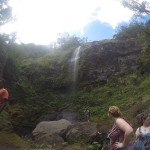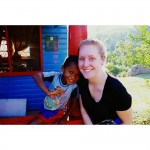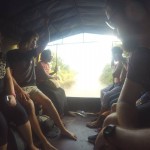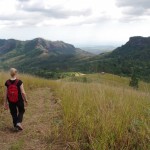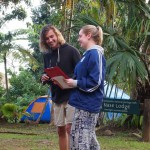Welcome to week 2 of my Fiji Trip, I know it is long, but it is well worth the read 🙂
To get to our second destination, Abaca village (located just outside of Nadi), we endured a 3-4 hours bus ride but it was well worth it. We loaded into a charter bus and began our journey. Along the way we stopped for lunch and a quick visit to Kula Eco Park. Kula Eco Park is Fiji’s only wildlife park. But they aren’t just any ordinary wildlife park, they provide a free environmental education facility for Fiji’s school children as well as assisting in species recovery through their captive breeding program. They even have a rope bridge! The first part of the park you walk through a range of bird species as well as some marine life (mainly coral and small fish species)and lizard species (including breeding programs for threatened species) before walking through a jungle-like path with all the trees and plants surrounding you, with Fiji fun facts along the way. The park as a whole reminded me of a small rainforest with a small amount of animal species and a whole lot of biodiversity.
After Kula Park, we stopped and had lunch at the Crow’s Nest Resort (funnily enough where I stayed for my first week before beginning the program) and then we were back on the road to complete our journey. We arrived at Nadi bus depot/station and awaited our transport to the village. The road was off-road so there was no way we could travel to the village in a charter bus. Instead we travelled in Fiji style. While some students travelled in a small bus/van, the rest of us travelled in the back of a semi-covered side-seater truck offering the best view (see picture below for a better visualisation). The ride to the village took about 30 minutes. As before during a village visit, we presented the village Chief with a Kava root, which was accepted and we were accepted into the village with a welcoming ceremony. Shortly after the ceremony, we made our way to our cabin where we would be staying for the week.
To help describe the living conditions, think back and I mean way back to primary or high school camp. A large cabin with two rooms filled with bunk beds (3 of them) and a communal area with a small kitchen and an outside toilet/shower. You got it, this is where we stayed so it reminded me of camp when I was younger! Unfortunately, it didn’t fit us all so we had some tents pitched outside for the remaining students. Throughout our stay we were catered for by the beautiful women of the village.I can’t forget to mention, the cabin had no electricity (except for the small power generator used at night for a light in the communal lounge area) and no hot water. So as you could imagine, many students opted for the no shower choice for the week and proceeded to clean themselves with baby wipes or swim in the nearby water holes. I admit, I braved the shower once to wash my hair….but once was enough. I know it doesn’t sound great and you are probably thinking ‘how did you survive’? But let me tell you, this was one of the most amazing experiences. Being disconnected from technology and living like a local was incredible. It really made you realise how lucky you were to have what you have back home.
Now to the study side of things. Those students involved with vegetation surveys and remote sensing spent the week up in the highlands on top of Mt. Batilamu (mainly the UniSA and USP students) while the rest of us stayed at base camp to conduct our bird surveys in Koroyanito National Park. Koroyanito National Park was beautiful, also having water holes and a waterfall, but was severely impacted by Cyclone Winston which hit Fiji earlier in the year. That being said, the bird life was more abundant then Colo-i-Suva as well as containing near-threatened, endangered and critically endangered bird species. The abundance of species, and so many threatened species, made it quite obvious as to why this national park is unique and why it is so important to conserve and protect the forest. Without this national park, the birds that are in danger and call Koroyanito National Park home could be severely impacted and potentially become extinct.
Over the days we conducted bird surveys along the national park’s walking track as well as along the grasslands walking track. These surveys were conducted in the morning and then data analysis was conducted in the afternoon after lunch.
Part of our assessment (this was a university topic after all) was finding creative ways of communicating our study and presenting to our fellow students the process of how one should conduct bird surveys and how to analyse the data. This was a really difficult task. It is hard to let loose, be creative and have fun when you are used to being told that presentations need to be serious and follow rigid guidelines for assessment; but not this time. Our lecturer actually made the assessment criteria based on science communication, which involves understanding both content but also being aware of delivery. We decided to present the results as a skit, and hoped it would be enjoyable and effective communication for those watching .
My partner Wes and I presented to the class and villagers how to record/score bird data based on their calls; we acted as if we were actually in the forest collecting data. The experience was interesting but surprisingly fun when you let go. That wasn’t our only presentation for assessment; at the end of the week, we presented our findings and compared biodiversity across the two locations, Colo-i-Suva and Abaca village.
As a group, we performed a skit to translate and communicate the data we had collected. Creatively presenting data taught me that you first need to understand the data and then find ways to effectively communicate, which helped to make us better ambassadors for science and better science communicators.
In addition to our daily biodiversity assessment, we had the privilege to visit the locals in the village and learn their story. I was overcome with a range of emotions. One of the lovely ladies who looked after us, Vicki, showed us around the village. She showed us where they grow their crops and how it works (each family has their own section), where their church is located and her home – well what used to be her home. In February, Fiji was hit by Cyclone Winston and unfortunately it destroyed her home. With a brave face, she recalled one of the worst days, when she feared for her life and for her family. She told us how she grabbed her son and retreated to the chief’s house where she sought shelter. She, her husband and her son lost everything except the clothes on their back. Her story was moving and tragic. The tour of the village was an eye-opener and made you feel blessed to be apart of the village for the week.
Each week in Fiji was different. The first week felt like city living, but we learned a lot and had some great experiences. I personally preferred the second week. The second week allowed us to live like locals and that is an experience I will never forget. Living together in a cabin with no technology to distract you really got the students meshing together and getting to know each other. We played old school games, including cards (Uno of course), chess and even charades. I think if we had stayed in apartments for the entire two weeks, we wouldn’t have bonded like we did. The remote experience also allowed us to bond with the lecturers and to get to know them better away from the classroom.
So, if you have the opportunity to travel abroad to study, then don’t think about it, just apply and go for it! Step outside your comfort zone and live like a local in a foreign country. Try different foods that you wouldn’t normally eat. Sleep in a dorm with people you barely know. Trust me, you won’t regret it. The experience was amazing and I have come away with so many stories and memories that will stick with me forever.
Tamara Lewis, a Bachelor of Science (Animal Behaviour) student, participated in Biodiversity and Ecosystem Health Across the Pacific in Fiji in July 2016
- Read Tamara’s first post here
- Watch the tour video here
- Read more stories through the New Colombo Plan here
- Check the New Colombo Plan funded opportunities here


